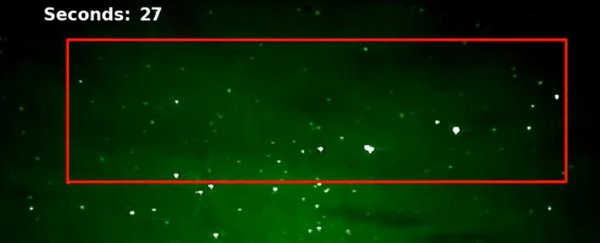Not all auroras slither through the sky like snakes. Some – called diffuse aurora – are more like an even glow dispersed throughout the sky.
Scientists know a fair bit about these diffuse auroras, but an old video from 2002 revealing what seems to be an undocumented auroral phenomenon shows we definitely don't know everything.
"We found these events in a movie taken the night of March 15, 2002 in Churchill, [Manitoba], Canada," the researchers write in a summary of their research.
"They appear as a section of diffuse aurora that rapidly brightens, then disappears and also erases the background aurora. Then, over the course of several tens of seconds, the diffuse aurora recovers to its original brightness."
The team, made up scientists from the University of Iowa, University of Calgary, and NASA, has dubbed the phenomenon 'diffuse auroral erasers'.
The researchers think this is the first time this phenomenon has been reported in the scientific literature, and they have no idea what's causing them.
"It raises the question: Are these a common phenomenon that has been overlooked, or are they rare?" says University of Iowa astronomer Allison Jaynes.
"Knowing they exist means there is a process that is creating them, and it may be a process that we haven't started to look at yet because we never knew they were happening until now."
Auroras are the dancing glow emitted by ionized particles in Earth's upper atmosphere. These particles are energized by solar winds, and their shedding of this excess energy creates the ethereal light we see.
Some auroras appear as discrete objects floating in the sky, whilst others are more diffuse – permeating equally over a wide area.
Diffuse aurora are linked to two specific types of atmospheric waves – electron cyclotron harmonic and upper‐band chorus – which can scatter electrons produced in the magnetosphere to create the glow.
Although this is well understood, scientists aren't sure how much each wave type contributes to the make-up of diffuse aurora, or even whether another type of waves – called whistler mode hiss waves – are also helping the process along.
The team hopes that identifying the diffuse auroral erasers from this old video will help answer some of these questions.
Although the published research is new, its origins began almost two decades ago. Back in 2002, David Knudsen, a physicist at the University of Calgary, captured the video footage on a cold night in Churchill.
While they saw very little on the night, when the video was analyzed later, the phenomenon was noticed by Knudsen, who scribbled in his notebook "pulsating 'black out' diffuse glow, which then fills in over several seconds".
However, the note wasn't followed up at the time, and it wasn't until recently that Jaynes handed the video and notebook to a graduate student to investigate further.
The graduate student, astrophysicist Riley Troyer, created a computer program to analyze the video, finding that it took on average 20 seconds for the aurora to 'recover' its brightness.
 (David Knudsen/University of Iowa)
(David Knudsen/University of Iowa)
Above: The 2002 notes written by Knudsen, referencing the "pulsating 'black out' diffuse glow".
"The most valuable thing we found is showing the time that it takes for the aurora to go from an eraser event (when the diffuse aurora is blotted out) to be filled or colored again and how long it takes to go from that erased state back to being diffuse aurora," says Troyer.
"Having a value on that will help with future modeling of magnetic fields."
There's plenty of research to still do, but the team hopes that now we know the erasers exist, we might be able to find more.
We just hope it won't take another 20 years to discover them.
The research has been published in the Journal of Geophysical Research: Space Physics.
